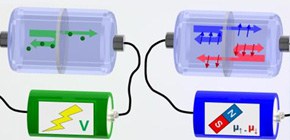
Detecting Excess Shot Noise Connected with a Spin Current
May open a novel way to approach non-equilibrium spin phenomena like spintronics
A group of researchers from Osaka University, Tohoku University, Kyoto University, and University of Regensburg (Germany) succeeded in generating a spin current in semiconductor devices and detecting excess shot noise connected with a spin current.
- Graduate School of Medicine, Osaka University -- ARAKAWA Tomonori , Assistant Professor, KOBAYASHI Kensuke , Professor
- Tohoku University -- SHIOGAI Jyunichi , Assistant Professor, KOHDA, Makoto , Associate Professor, NITTA Junsaku , Professor
-
- Kyoto University -- ONO Teruo , Professor
- University of Regensburg -- Dieter Weiss, Professor
How can we electrically detect spin current? In 1918, Schottky argued that the electric flow in a vacuum tube shows peculiar whose amplitude is proportional to elementary charge and to the mean current. This is shot noise, a direct consequence of the discreteness of the electric charge. Now, consider the discreteness of spin. By using a spin-valve-type solid-state device, we successfully detected the shot noise induced by a non-equilibrium spin accumulation. The observed shot noise is proportional to the spin current, yielding a spin analogue of Schottky's argument. Our experimental demonstration could open a novel way to approach non-equilibrium spin phenomena like spintronics.
Abstract
When an electric current passes across a potential barrier, the partition process of electrons at the barrier gives rise to the shot noise, reflecting the discrete nature of the electric charge. Here we report the observation of excess shot noise connected with a spin current which is induced by a nonequilibrium spin accumulation in an all-semiconductor lateral spin-valve device. We find that this excess shot noise is proportional to the spin current. Additionally, we determine quantitatively the spin-injection-induced electron temperature by measuring the current noise. Our experiments show that spin accumulation driven shot noise provides a novel means of investigating nonequilibrium spin transport.
Fig 1. Schematic diagram of the measurement system.
By applying a constant current to a ferromagnetic (Ga,Mn)As electrode, we inject spin polarized electrons into the n-GaAs channel. As a result, a spin current is generated and flow into another ferromagnetic electrode. This spin current lead to a current fluctuation through the tunnel junction.
Fig 2. Schematic diagram of shot noise.
(left figure) When a tunneling barrier is biased by a voltage source, a charge current is generated. Each electron is randomly transmitted or reflected at the barrier. This partition process results in the conventional charge shot noise. (right figure) In the presence of a spin current, which consists of the up-spin current and the down-spin current, also generates the shot noise due to the partition process. Note that this phenomenon may occur even without net charge current.
To learn more about this research, please view the full research report entitled " Shot Noise Induced by Nonequilibrium Spin Accumulation " at this page of the Physical Review Letters website.
Related Link
